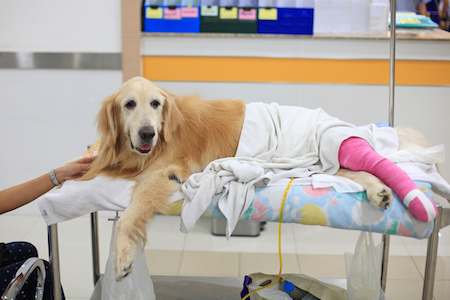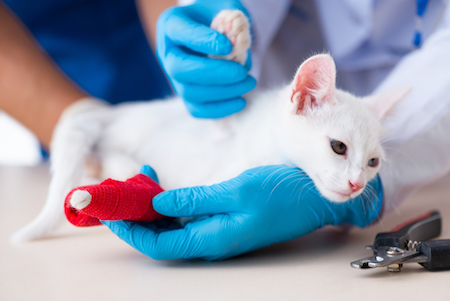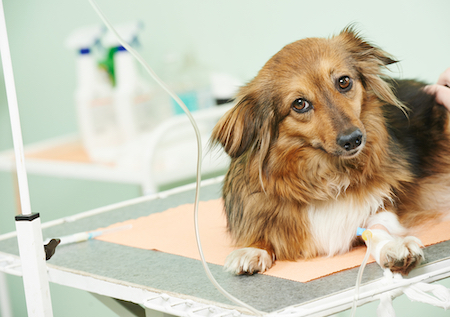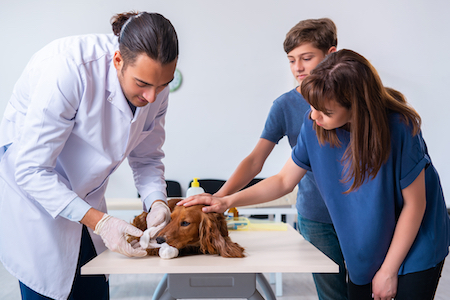How to Recognize a Real Pet Emergency
Posted: 09/14/2022 | BY: Erin Cain | Categories: Cat , Dog , Health problems , Pet care , Top Tips
As a pet parent, it’s essential to recognize when your pet is in danger and needs immediate medical attention. Many people don’t know what constitutes a real pet emergency, and they may wait too long to take their pet to the vet. This dilemma can result in serious health problems for the animal. This blog post will discuss 9 tips for recognizing a real pet emergency.

What is a real pet emergency?
“Should I wait until morning, or should I go to the vet now?” Pet parents the world over ask this question every day. To stay or go to the emergency veterinarian clinic is a tough decision for pet owners, but one that could be critical in saving your furry friend. So what constitutes pet emergencies that require urgent care?
If you notice your pet acting differently than usual or something doesn’t seem right, it could be a sign of an issue with their health. The best way to tell if your pet needs emergency care is by asking a few questions over the phone. Emergency veterinarians will be able to answer whether she should come in right away or wait until office hours at your local veterinarian’s office.

9 Pet Emergency Tips for Pet Parents
Whether it’s a minor or severe issue, always choose caution when your pet is injured or wounded. Bring her in to see the vet immediately if you’re concerned about any possible symptoms or behavioral issues they are exhibiting.
Remember to have your pet’s medical records on hand so that you can access them quickly. It’s imperative to have them if your pet sees a different vet at another animal hospital. Additionally, have a pet first aid kit for everyday bumps and scrapes and begin initial procedures as you transport your dog or cat to animal hospitals.
Here are the top 9 emergencies where your pet needs to see a veterinarian immediately.
1. Mobility issues
Limping
Limping is a common problem for pets that does not always require emergency care. Soft tissue trauma, such as strained muscles and ligaments, can cause mobility issues in your cat or dog for some time. However, suppose you notice any signs or symptoms of injury or lameness in your pet or your pet’s behavior is not normal. She may have been involved in a traumatic incident, such as a car accident, a fight, or a fall. Call your vet quickly to have any trauma and injury examined and treated immediately.
Paralysis
Rush your dog or cat to an emergency clinic if she cannot walk, is struggling to walk, or is dragging her back legs. Paralysis is caused by a blood clot blocking perfusion to the back legs or spinal cord compression from ruptured intervertebral discs. It’s imperative in a paralysis situation that your pet gets medical treatment as quickly as possible. The faster the treatment takes place, the better the chance your pet can regain her ability to walk and live normally.
2. Seizures
Various conditions cause seizures in pets. Some of the most common are:
- cancer
- liver disease
- epilepsy
- head injury
- brain swelling
- toxin exposure
When your pet has her first seizure, she needs to be evaluated by a veterinarian. Determining the cause of this event will help your pet get better or even prevent future brain convulsions. While epilepsy alone is not considered an emergency, it can become one if the potential causes are toxicity or brain swelling. A grand mal or cluster seizure can indicate a more significant underlying medical issue. These should be treated quickly because they may lead to life-threatening conditions.
If your pup or kitty has a seizure that lasts longer than five minutes or she experiences more than one event during 24 hours, it’s vital to get her to a veterinary team immediately.

3. Severe bleeding and trauma
Treat minor cuts and abrasions quickly. However, suppose they do not stop bleeding within five minutes. If the wounds are deep or the bleeding becomes severe, take your pet to the vet or an emergency department for immediate care. Keep pressure on the wound to slow the bleeding until the vet can examine your furkid. If her injuries penetrate the abdomen or thorax, your pet will need emergency care.
Pets who suffer from traumatic injuries must be taken to a veterinarian or emergency clinic. Suppose your cat or dog is hit by a car, dropped down steps, takes a nasty fall, or gets into a scrape with other animals. In that case, it’s essential to get her evaluated immediately so that surgery (if necessary) and treatment protocols can start. Immediate attention is vital for the pet’s safety. Your furry friend may seem fine at first glance, but she should still be assessed to ensure there aren’t any unapparent injuries, such as internal bleeding or injuries.
4. Difficulty breathing
A pet experiencing breathing difficulties, such as open-mouth breathing, choking, panting, wheezing, gagging, or continuously coughing, needs to be rushed to a clinic for veterinary care. These signs can indicate a serious issue with the lungs and may quickly become fatal. Check the color of your pet’s gums. If they are gray, pale, or blue-tinged, it can indicate critical danger. Emergency treatment is necessary for this situation.

5. Vomiting or inability to eliminate
All pets vomit at some point in their lives, and it’s often not a big deal. However, in some circumstances, excessive or frequent vomiting is a sign of a much larger problem. If your pet vomits 3 times or more in 24 hours, has a loss of or decreased appetite, shows signs of fatigue, or has diarrhea at the same time — especially dark, bloody, or pure liquid stool — it’s an emergency. Also, if your pet has a fever of over 104 degrees Fahrenheit for dogs or 102.5 degrees for cats, that is a red flag that your pet needs help fast.
Attempting to vomit but failing is also a dangerous sign. Retching without producing anything or distension of the abdomen, where it is noticeably more prominent and firm, constitutes an emergency. Without immediate care, a pet can be dead in hours.
Dogs and cats can suffer from various painful conditions, including bladder stones or blockages. If you notice your pet has been struggling to urinate successfully without succeeding, it’s best to consult with a veterinarian immediately. Additionally, toxins normally eliminated in the urine can build up and cause significant illness. When your pet strains to urinate, it’s a medical emergency that warrants an emergency visit.

6. Eye injuries
The eye is one of the most vulnerable parts of a dog and cat, and ocular injuries can occur differently. Damage to an animal’s eyes often leaves them with vision loss or even blindness. Here are the types of eye injuries that should be treated as emergencies:
- orbital bone injuries
- cornea injuries
- eyelid injuries
- eye leaks
- foreign object injuries
These organs are so sensitive and delicate that professional veterinarians are the best people to diagnose and treat the problem. In some cases, your pet may need minor surgery to remove an object so that the eye can heal properly.
7. Exposure to toxins
Pets are always finding a way to get into something they shouldn’t. Sometimes it’s snooping around in your chocolate stash. Other times it’s stealing one of grandma’s pills from her medicine cabinet. Unfortunately, foods like chocolates and prescription medications are toxic to pets. When our furkids ingest them, pet emergencies are bound to happen.
Many environmental toxins are tempting to our furkids, from plants to antifreeze. Call the veterinarian right away if you think your pet has been exposed to a toxic substance and is experiencing poisoning. You may also call the ASPCA Poison Control or the Pet Poison Helpline for additional advice and assistance.

8. Heatstroke
Hypothermia is a medical event commonly associated with dogs; however, cats can also suffer from this condition. If a pet’s body temperature exceeds 103°F, it is considered abnormal or hyperthermic and can lead to heatstroke. This severe condition can be fatal if not treated quickly. When body temperatures exceed 106°F, without previous signs of illness, this may indicate excessive external or environmental heat exposure. The critical temperatures between 107°F to 109 ° F are where multiple organ failures and impending death occurs.
With this medical emergency, you must reduce your pet’s body temperature as quickly and safely as possible, with cool water applied with or without a cloth to the head, armpits, stomach, and feet. If using cool, wet cloths for treatment purposes, continuously replace them, or they will start retaining heat. You can apply these cooling methods to your dog on the way to the animal emergency clinic.
9. A distended, bloated abdomen
Your pet may be experiencing minor abdominal pain and discomfort if she:
- winces when you touch her abdomen;
- has a guarded posture while walking;
- flinches at being felt in the stomach area.
Sometimes pets have some abdominal pain that is a minor problem, such as gas. But these symptoms may also indicate a more dangerous condition that requires immediate treatment.
When a life-threatening condition, such as intestinal torsion, bloat, or gastrointestinal obstruction, is present, pet owners should seek medical help quickly. It’s better to be safe than sorry. If you aren’t sure if your dog’s stomach pain qualifies as an emergency, call your vet or local pet emergency clinic.

Accidents happen; pet insurance can help.
Whether your dog is injured in an accident or your cat suffers from eye trauma, every pet parent knows how much veterinary bills can cost. Emergency clinic costs are even higher and difficult for some pet owners to afford. Don’t put yourself in a position where you need to choose between your financial capabilities and your pet’s health. With a pet health insurance plan, you can rest assured that your dog or cat gets advanced care, and your provider will reimburse you for most of the cost.
At Pet Insurance Review, we’re all about saving pets’ lives and saving pet owners money. Above all, we want your pet to be healthy and happy so you can spend as much time with your furkid as possible. We can help you find a health insurance policy that’s right for your pet. Fill out your pet’s information today and get a free insurance quote to protect your furkid’s tomorrow.
References:
- Mar Vista Animal Medical Center. (2022). Care of the Paralyzed Animal. Retrieved from https://www.marvistavet.com/care-of-the-paralyzed-animal.pml
- MedVet. (2022). Seizures in Pets — Knowing the Signs and What To Do. Retrieved from https://www.medvetforpets.com/seizures-in-pets/
- Memphis Veterinary Specialists & Emergency. (2022). Heavy Bleeding in a Dog or Cat That Won’t Stop. Retrieved from https://www.memphisveterinaryspecialists.com/site/blog-cordova/2019/10/15/heavy-bleeding-in-a-dog-or-cat-that-wont-stop
- Greencross Vets. (2022). Vomiting in Pets. Retrieved from https://www.greencrossvets.com.au/pet-library/articles-of-interest/vomiting-in-pets/
- Davies Veterinary Specialists. (2022). Fever Fact Sheet. Retrieved from https://vetspecialists.co.uk/fact-sheets-post/fever-fact-sheet/
- Bozeman, E. (2020). Treatment of Hypothermia in Dogs and Cats. Retrieved from https://www.medvetforpets.com/treatment-of-hypothermia-in-dogs-and-cats/
- Grognet, J. (2021). Bloat (or GDV) in Dogs — What It Is and How it’s Treated. Retrieved from https://www.akc.org/expert-advice/health/bloat-in-dogs/
The information contained on this blog is intended for informational and educational purposes only and should not be construed as medical advice. It is not a substitute for professional veterinary care. Always consult with your veterinarian before making any changes to your pet's health care or treatment plan.
The authors of this blog are not veterinarians and do not claim to be experts in pet health. The information provided here is based on our own experiences and research, as well as information from reputable sources. However, we cannot guarantee the accuracy or completeness of this information.
We encourage you to do your own research and consult with your veterinarian before making any decisions about your pet's health.
Previous post
How to Help a Dog With Cracked or Broken ToenailsNext post
Laser Therapy for PetsCompare top pet insurance providers plans.
Enter your dog’s age in years and months to calculate their age equivalent to human years.
Calculate your dog’s ageEnter your cat’s age in years and months to calculate their age equivalent to human years.
Calculate your cat’s age